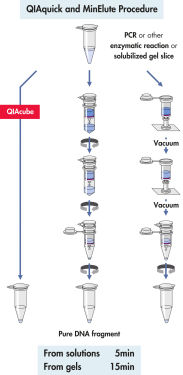QIAquick Gel Extraction Kit – ゲル精製
ゲルまたは酵素反応液からの最大10 µgのDNA(70 bp ~ 10 kb)の効率的抽出・クリーンアップ用
ゲルまたは酵素反応液からの最大10 µgのDNA(70 bp ~ 10 kb)の効率的抽出・クリーンアップ用
✓ オンライン注文による24時間年中無休の自動処理システム
✓ 知識豊富で専門的な製品&テクニカルサポート
✓ 迅速で信頼性の高い(再)注文
Cat. No. / ID: 28704
✓ オンライン注文による24時間年中無休の自動処理システム
✓ 知識豊富で専門的な製品&テクニカルサポート
✓ 迅速で信頼性の高い(再)注文
QIAquick Gel Extraction Kitは、ゲル(最大400 mgまで)または酵素反応液からDNAフラグメントをシリカメンブレンスピンカラム、バッファー、およびコレクションチューブで構成されます。70 bp ~ 10 kbのDNAを、シンプルで迅速な結合-洗浄-溶出の操作および30–50 µlの溶出液量で精製します。組み込まれたpH指示薬により、スピンカラムへのDNA結合の至適pHを容易に確認できます。QIAquick PCR & Gel Cleanup Kitは、100 bp~10 kbのPCR産物を精製するためのバッファーも提供します。この操作は、QIAcube Connect上で完全自動化できます。
最適な結果を得るには、本製品をQIAvac 24 Plusと併用することをお勧めします。
QIAquick Gel Extraction Kitは、サンプルからヌクレオチド、酵素、塩、アガロース、臭化エチジウムなどの不純物を除去して、最大80%のDNAの回収率を保証します(「 ゲルからの高回収率」の図を参照)。小型遠心機または真空マニホールドを使用して、1–24サンプルから70 bp ~ 10 kbのDNAを精製します。精製されたDNAは、たとえばシークエンシングで使用できます(「 ゲル抽出後の信頼性の高いシークエンシング」の図を参照)。70 bpより小さいまたは10 kbより大きいDNAフラグメント精製は、QIAEX II Gel Extraction Systemを使用して下さい。
QIAquick PCR Purificationの手順は、DNAサンプルからプライマー、ヌクレオチド、酵素、ミネラルオイル、塩などの不純物を除去します(「 PCR後の完全なプライマー除去」の図を参照)。小型遠心機または真空マニホールドを使用して、100 bp ~ 10 kbのDNAを精製します。
QIAquick Kitsは、高塩濃度バッファーでDNAを結合し、低塩濃度バッファーまたは水で溶出するためのシリカメンブレン技術です。この精製操作は、DNAサンプルからプライマー、ヌクレオチド、酵素、ミネラルオイル、塩、アガロース、臭化エチジウムなどの不純物を除去します(「 ゲルからの高回収率」の図を参照)。シリカメンブレン技術は、緩い樹脂やスラリーに伴う問題や不都合がありません。特殊な結合バッファーは、特定のアプリケーション向けに最適化され、特定のサイズ範囲内でのDNA分子の選択的吸着を促進します。
ローディングダイは、迅速で便利なサンプル処理と分析を可能にします。GelPilot Loading Dyeは、3種類のトラッキングダイ(キシレンシアノール、ブロモフェノールブルー、およびオレンジG)を含み、アガロールゲルのランタイムの最適化を容易にし、より小さなDNAフラグメントの過度な移動を防ぎます(「 GelPilot Loading Dye」の図を参照)。
QIAquick systemシステムは、シンプルな結合-洗浄-溶出の操作です(「 QIAquickおよびMinEluteの操作手順」のフローチャートを参照)。ゲルスライスは、pH指示薬を含むバッファーに溶解するので、DNA結合の至適pHを容易に確認でき、混合液をQIAquickスピンカラムにアプライします(「 pH Indicator Dye」の図を参照)。核酸は、バッファーの高塩濃度の条件下でシリカメンブレンに吸着します。不純物は洗い流され、純粋なDNAが、提供される少量の低塩濃度バッファーまたは水と共に溶出し、様々なアプリケーションに使用できます。
QIAquickスピンカラムは、2通りの操作が設定されています。スピンカラムは、小型遠心機またはQIAvac Luer Adapters付きのQIAvac 24 Plusなどのルアーコネクター付きの真空マニホールド上にフィットします。QIAquick Gel Extraction Kitは、その他のQIAGENスピンカラムキットに加えて、QIAcube Connectで完全自動化して、生産性の向上、結果の標準化することができます(「スピンカラムの取り扱いオプション A、 B、 C、 D」および「 QIAcube Connect」の図を参照)。
QIAquickシステムで精製したDNAフラグメントは、シークエンシング、ライゲーションと形質転換、制限酵素消化、標識、マイクロインジェクション、PCR、およびin vitro転写などすべてのアプリケーションで使用できます。

| Features | Specifications |
|---|---|
| Binding capacity | 10 µg |
| Format | チューブ |
| Fragment size | 70 bp ~ 10 kb |
| Recovery: oligonucleotides dsDNA | 回収:dsDNAフラグメント |
| Processing | 手動 |
| Removal <10mers 17–40mers dye terminator proteins | 除去<10mers |
| Elution volume | 30 ~ 50 µl |
| Technology | シリカテクノロジー |
| Sample type: applications | DNA:PCR反応 |